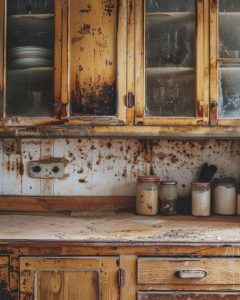
Welcome to your guide on tackling the challenging mess of sticky and greasy kitchen cabinets! Neglecting to regularly clean kitchen surfaces can lead to a daunting buildup of grime that seems nearly impossible to remove. After three years without a proper scrub, your cabinets may seem like they’re coated with a permanent layer of yuck, but fear not!
The following steps will guide you through a systematic approach to clean your kitchen cabinets and restore their shine.
Step 1: Gather Your Cleaning Supplies
Before you begin the process of cleaning, it’s important to gather all necessary items to ensure an efficient and effective cleanup. Here’s what you’ll need:
1. A bucket filled with warm water
2. Dish soap or a degreasing cleaner
3. Baking soda
4. White vinegar
5. Clean microfiber cloths or sponges
6. Rubber gloves
7. Soft-bristled brush or an old toothbrush
8. Optional: Essential oil (like lemon) to add a pleasant scent to your cleaning solution
Step 2: Empty the Cabinets and Prep the Area
Start by removing all items from your cabinets. Wipe down any items that may have collected grease or grime before putting them back. Cover your countertop and flooring near the cabinets with old newspaper or towels to catch any drips of your cleaning solution. Wearing rubber gloves will protect your hands from any harsh cleaning agents.
Step 3: Make Your Cleaning Solution
Mix a few drops of dish soap or a degreasing cleaner into your bucket of warm water. If you prefer a natural cleaner, combine equal parts of water and white vinegar with a tablespoon of baking soda for an extra boost in grease-fighting power. You can add a few drops of essential oil for fragrance if you like.
Step 4: Begin Washing the Surfaces
Dip your cloth or sponge into the solution and wring out excess liquid. Start washing the cabinets, paying extra attention to areas with thick buildup. You can use the soft-bristled brush to gently scrub any particularly stubborn spots. Remember to regularly rinse your cloth or sponge to avoid spreading the grease.
Step 5: Tackle Tough Spots with Baking Soda Paste
Make a paste with baking soda and water for areas that are not responding to the liquid cleaner. Apply to the greasy spots, let it sit for a few minutes, and gently scrub with your brush. The natural abrasive nature of baking soda helps lift the grime without scratching the cabinets.
Step 6: Rinse and Dry the Cabinets
After scrubbing, it’s time to remove any remaining cleaner. Wipe the cabinets down with a clean, damp cloth to rinse the surfacing, following with a dry microfiber cloth to prevent streaks and spots.
Step 7: Polish and Maintain Your Cabinets
To add an extra level of shine and protect the wood, consider applying a wood polish in accordance with the manufacturer’s guidelines. From now on, to avoid another heavy buildup of grease, wipe down the cabinet surfaces with a mild cleanser once a week.
Conclusion
With patience and elbow grease, you can transform your sticky and greasy kitchen cabinets into a sparkling part of your home once again. Remember to maintain a regular cleaning routine to keep them looking their best and to prevent future buildup. Happy cleaning!